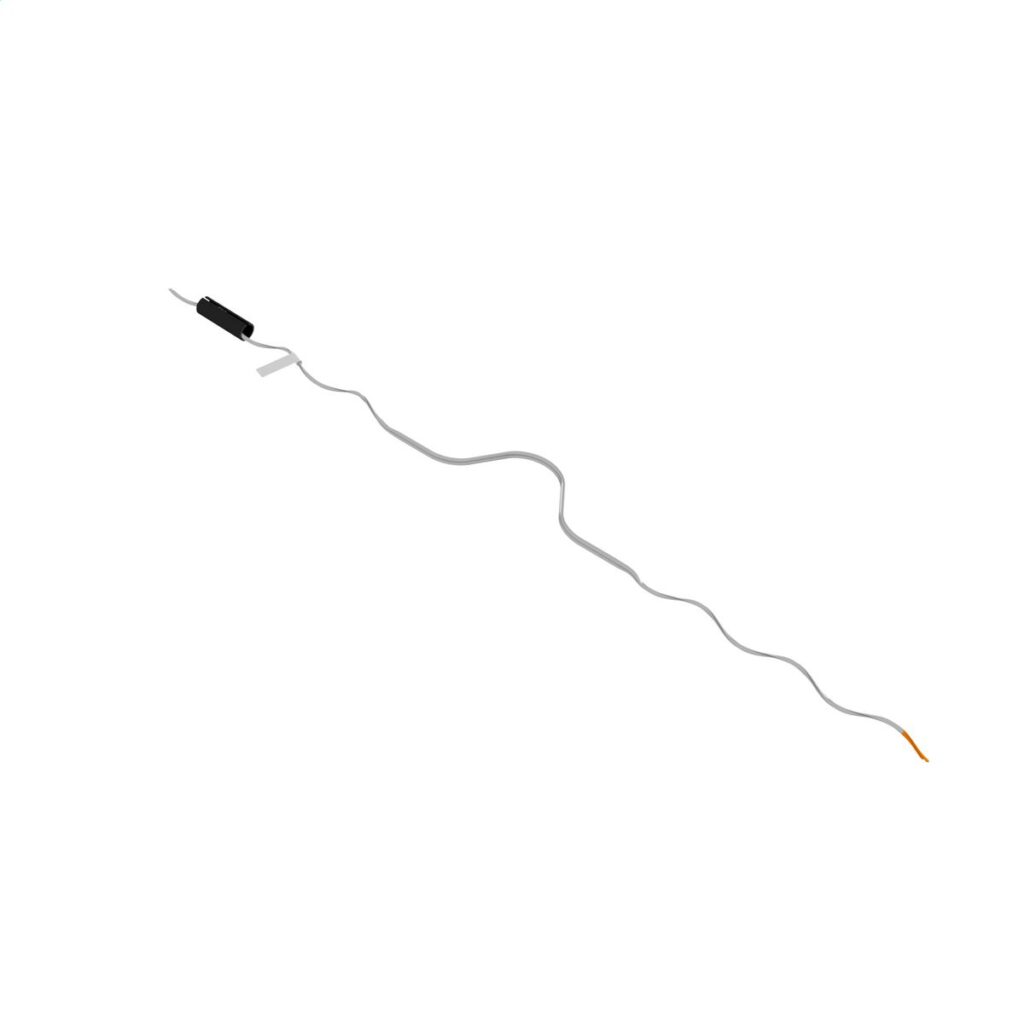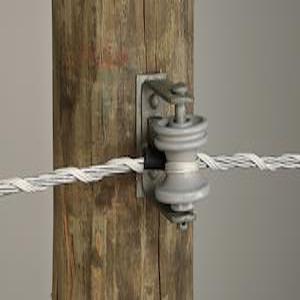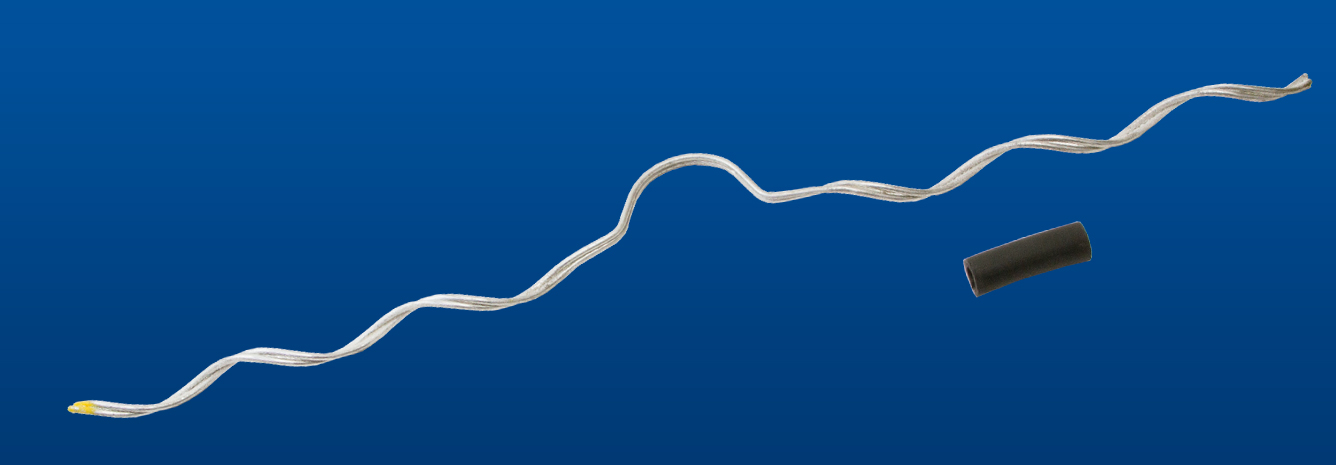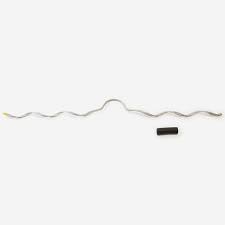
A spool tie is a piece of hardware used for installing ADSS and OPGW cables on utility poles and towers. It offers a secure and dependable technique of connecting the cables to their support structures. It features a helical shape that wraps around the wires and support structures. The spool tie has a main body and cushions to protect the cable from wear and damage. They comprise of materials like aluminum or galvanized steel, which give both corrosion resistance and strength. The spool tie distributes the load along the cable and support structures. They also help to connect ADSS and OPGW wires to insulators and other support structures. Spool ties can help mitigate vibrations and thereby cut wear and strain on the cables.
Fittings used with spool tie for ADSS/OPGW cables.
Spool ties are compatible with a variety of accessories to enable secure connection, cable protection, and reliable performance. Each of these accessories plays an important function in protecting the cables from mechanical stress and weather conditions. The following are the necessary accessories for ADSS/OPGW cables when using spool ties.

- Armor rods – these protect the cable from mechanical stress, abrasion and environmental factors. The armor rods have a helical shape that wraps around the cable where the spool tie attaches. They distribute mechanical loads and prevent damage from bending.
- Cushion inserts – these provide a soft interface between the cable and the spool tie. They protect the cable from direct contact with the hard metal surface. These cushions install around the cable before wrapping the spool tie.
- Thimbles – thimbles provide a smooth bearing surface to protect the cable and maintain proper alignment. They are U-shaped metals pieces that fit inside the loop of the cable where it attaches to the support point.
- Vibration dampers – these reduce Aeolian vibrations caused by wind which can lead to fatigue damage. They consist of weights attached to a flexible rod that absorbs and dissipates the vibrational energy.
- Cable ties and clamps – these help to secure the cable and the spool tie to the support structure to ensure stability. They can be adjustable or fixed to the cables.
- Dead end clamps – these help to terminate the cable at the end of a span or at a pole. They grip the cable without causing damage to the cables.
- Tensioning devices – these devices apply the necessary tension to the cable during installation. They help in maintaining the correct sag and tension in the cable to prevent excessive slack.
- Insulators – these help to electrically isolate the cable from the support structure. It prevents electrical faults and ensures safe operation.
Roles of Spool Tie in ADSS/OPGW Cables
Spool ties are essential for installing and maintaining ADSS/OPGW wires. Spool ties ensure that the ADSS/OPGW cables operate securely and efficiently. They also ensure that the cables remain in position and perform properly. The spool tie in ADSS/OPGW cables performs the following common roles.

- Secure attachment to support structures – spool ties attach ADSS and OPGW cables to support structures. They provide a means of bearing the mechanical load of the cables to ensure they remain firm in place.
- Load distribution – spool ties distribute the mechanical load along the length of the cable and support structure. The even distribution helps in reducing stress on the cable at the points of attachment.
- Vibration dampening – spool ties help to dampen the vibrations caused by wind which can lead to cable fatigue. Spool ties contribute to the longevity of the cable by protecting it from mechanical fatigue.
- Protection from abrasion and damage – spool ties work with cushion inserts. They help protect the cable from abrasion against the support structure.
- Maintaining cable tension – spool ties help in maintaining the correct tension and sag of these cables. This is crucial for preventing excessive slack that could lead to issues. They allow the tension of cable during installation to achieve the desired sag and alignment.
- Flexibility and ease of installation – the helical design of spool ties allow for easy installation without need for special tools. The ties can work with various cables sizes and types which makes them a versatile solution for installations.
- Prevention of slippage and movement – the design of the spool ties ensures a secure grip on the cable to prevent slippage and movement. They maintain the proper function and signal transmission.
- Cost effective solutions – spool ties provide a cost-effective solution for securing ADSS and OPGW cables. This helps reduce the need for expensive and complex mounting of hardware.
Spool ties for the ADSS cables
Spool ties used with ADSS cables have distinct properties. These features make them ideal for security and fastening. The design and material qualities of spool ties aim to suit the requirements of these installations. Also, these properties ensure that the cables are securely attached and reliable throughout time. The spool ties used for ADSS cables have the following properties.

- Helical design – spool ties have a helical or spiral shape that allows them to wrap around the ADSS cable and support structure. The helical design helps in distributing the mechanical load along the cable and the structure.
- Non-metallic contact – spool ties must ensure no metal-to-cable contact to avoid electrical conductivity issues. The dielectric materials in the contact areas helps prevent electrical conduction. It also ensures the safe attachment of the cable.
- Protective cushioning – the ties have cushion inserts made from rubber that provide a soft interface between the cable and metal parts of the tie. Cushioning helps protect the cable from abrasion and mechanical wear.
- Corrosion resistance – spool ties are from corrosion-resistant materials that protect them in outdoor installations. They also ensure the spool ties maintain their structural integrity and functions.
- Mechanical strength – the ties have designs to handle the mechanical loads related to supporting ADSS cables. The materials ensure the ties can withstand the mechanical forces without failure.
- Compatibility with ADSS cables – spool ties have designs to match the specific diameter and mechanical properties for ADSS cables. The spool ties are non-magnetic to avoid any interference with the cable’s function.
- Compliance with standards – spool ties should follow industry standards and regulations for the installation of ADSS cables. The compliance ensures the spool ties meet the necessary quality and safety need for effective cable support.
Spool ties for OPGW cables
Spool ties for OPGW cables have special features designed to attach and support the cables. OPGW cables serve the purpose of a ground wire while also providing fiber optic communication capabilities. They also offer designs to meet the dual requirements of grounding and optical data transfer. Spool ties help to ensure reliability and long-term performance. The following are the features of spool ties for OPGW cables.

- Helical design – spool ties for OPGW cables are helical in shape to wrap around the cable and support structure. This design helps to distribute the mechanical load along the cable and the attachment point.
- Material strength and durability – the ties are from high strength materials like steel and aluminum. These materials provide the necessary tensile strength to support OPGW cables. The materials also offer corrosion resistance for outdoor installations.
- Electrical conductivity and insulation – the ties need to manage electrical conductivity of the cables. They also have insulated contact points that prevent direct metal-to-cable contact.
- Cable protection – the ties provide protection against abrasion and mechanical wear. They also have cushions made from rubber that prevent the cable from exposure to metal surfaces.
Conductors that operate using spool ties
Spool ties use particular conductors intended to meet the mechanical and electrical needs of the systems. The conductors must ensure secure attachment, efficient load distribution, and consistent electrical performance. The following conductors function with spool ties in ADSS/OPGW cables.

- Aluminum clad steel conductors (ACS) – these conductors consist of a steel core that is clad with a layer of aluminum. This combination provides the strength of steel with corrosion resistance and conductivity of aluminum. They work with OPGW cables where mechanical strength and good conductivity are necessary.
- Aluminum alloy conductors – these conductors are from aluminum alloy. Aluminum alloy provides a good balance between strength, weight and conductivity. They work in both ADSS and OPGW cables to provide corrosion resistance.
- Galvanized steel conductors – these are steel wires coated with a layer of zinc to protect against corrosion. They work in OPGW cables for their high tensile strength and durability.
- Copper conductors – these are from high purity copper and are good electrical conductors. Copper conductors sometimes work with specific types of OPGW cables that need electrical performance.
- Stainless steel conductors – they are resistant to corrosion and can handle a wide range of temperatures and environmental conditions.
Frequently asked questions
Spool ties for ADSS cables are helical, have non-metallic contact points and protective cushioning. They also ensure a secure fit while preventing electrical conductivity issues.
Spool ties protect cables from mechanical stress, abrasion, and environmental damage. They serve to send loads and cut vibration, minimizing early wear and extending the cable’s lifespan.
OPGW cables function as both a ground wire for electricity transmission and a conduit for optical fiber communication. They provide grounding and lightning protection while allowing data transfer.